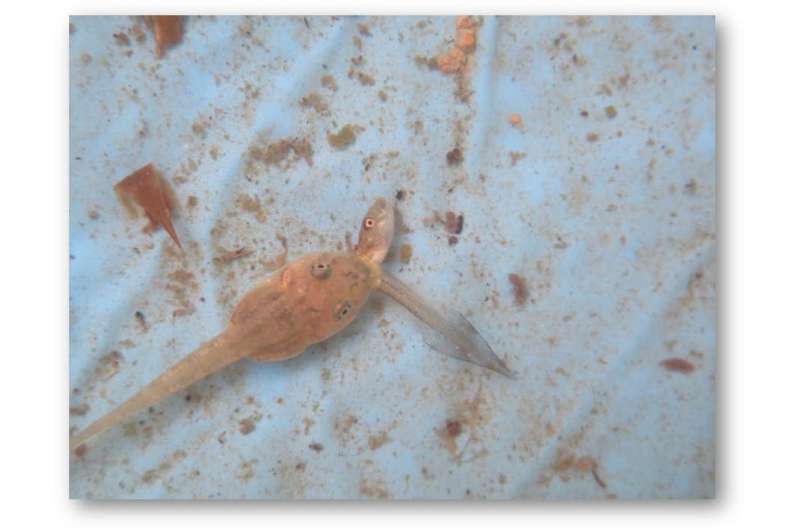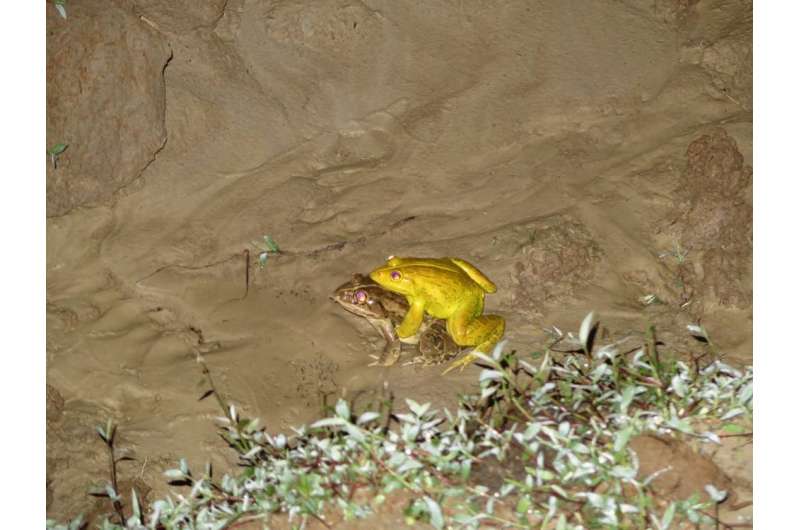Carnivorous bullfrog tadpoles don’t even spare their own. Author supplied
The Indian bullfrog, which is native to the Indian sub-continent, has recently invaded the Andaman archipelago. This group of islands lies about 1200 km east of the Indian mainland. The bullfrog was probably introduced to the archipelago in the early 2000s – either as adults released for human consumption, as tadpoles that contaminated aqua-cultural stocks, or both.
In these tropical islands of the Bay of Bengal, this large frog – it can grow up to 160 mm in length, a good three to five times larger than the native frogs – has spread remarkably fast. This is cause for concern, both ecologically and economically. That's because of the frog's "anything goes" attitude to feeding. The adults prey on a host of endemic vertebrates, including fishes, frogs, lizards, snakes, and even birds. The bullfrog doesn't even spare poultry, which many households on the islands keep, making their invasion a problem for the economy too.
Our new study reveals that not only the adult bullfrogs pose a threat to the Andaman archipelago's native frog species: their tadpoles do, too.
We conducted an experiment, simulating real-life conditions, which revealed that no individuals from two native frog species survived the feeding onslaught of the Indian bullfrog's tadpoles. That's a level of predation which has never been documented before for the tadpoles of any invasive frog.
If native tadpoles are such easy prey for this carnivorous bullfrog's tadpoles, their populations could face serious decline. They may even be entirely wiped out on the Andamans. New frog species are often discovered on these islands, and the bullfrog's tadpoles could also put these at risk.
The experiment
The Andaman tree frog and the Chakrapani's narrow-mouthed frog are found only on the Andaman archipelago. There are many other plant and animals species that are endemic to the Andamans; this uniqueness in diversity has conferred the "biodiversity hotspot" tag on the archipelago.
The Indian bullfrog is a recent entrant to these isolated islands. It breeds in the same paddy field pools and plantations as the narrow-mouthed frog and the tree frog. As all three species breed at the onset of the south-west monsoon in May, their tadpoles begin the process of development together.
We wanted to understand how native tadpoles responded to carnivorous bullfrog tadpoles. Would the native tadpoles be able to outmanoeuvre these tadpole predators? Would bullfrogs out-compete native tadpoles for food and slow down their growth and reduce survival?
To answer these questions, we replicated the tadpoles' breeding grounds by setting up paddling pools – the sort that are appropriate for humans aged between three and ten. Combining the three frogs in all possible permutations, we tasked ourselves with monitoring a total of 25 pools. We were interested in how the tadpoles fared in terms of survival and growth. Tadpole density and the food that's available are known to affect these parameters, so we kept these equal for all treatments.
Each pool had a total of 30 tadpoles, with equal representation of species in the treatments with more than one species. We replenished each pool with 40g of submerged leaf litter and changed the water (containing zooplanktons) every week.
Bullfrogs in action: mating on the night of first heavy rains. Author supplied
Predator and prey
The stage was set.
As soon as the experiment commenced, the carnivorous bullfrog tadpoles started their feeding frenzy. They preyed on the two native species and even cannibalised each other.
This happened so quickly that only three of the pools were left with any surviving native tadpoles in the first week. The native tadpoles had been completely exterminated from the mixed species pools by the third week.
Bullfrog tadpoles grew with each hunt, enabling them to prey upon even more hapless native tadpoles. When left to themselves, the native tadpoles did much better, with three in every four making it to the finish line of metamorphosis – that is, they eventually turned into frogs.
The bullfrog tadpoles were so voracious that we weren't even able to answer one of our questions: Would bullfrogs slow down native tadpoles' growth? That's because we had no native tadpoles left to measure.
The Chakrapani's narrow-mouthed frog and the Andaman tree frog tadpoles that were kept away from the chomping bullfrog tadpoles transformed into terrestrial juveniles (known as metamorphs) in 21 days and 38 days, respectively.
What this means
Our experiment reveals that in natural conditions, native frogs – many of which breed in similar habitats as invasive bullfrogs – are highly vulnerable as tadpoles.
The findings also emphasise the potential impact that invasive bullfrog tadpoles can have at the level of populations. They can severely reduce the number of freshly minted metamorphs joining the native species populations. Of course, the situation is made more complicated in natural settings by the presence of other predators like dragonflies; and the availability of alternative food sources like mosquito larvae.
Still, our results suggest that the tadpole stage of Indian bullfrogs is to be taken seriously while understanding the impact of the species on native frogs. This may have implications elsewhere: the world is witnessing an accelerating rate of frog invasions. Invasive frog populations' tadpoles could have a serious, damaging impact far beyond the Andamans.
Provided by The Conversation
This article is republished from The Conversation under a Creative Commons license. Read the original article.![]()

























